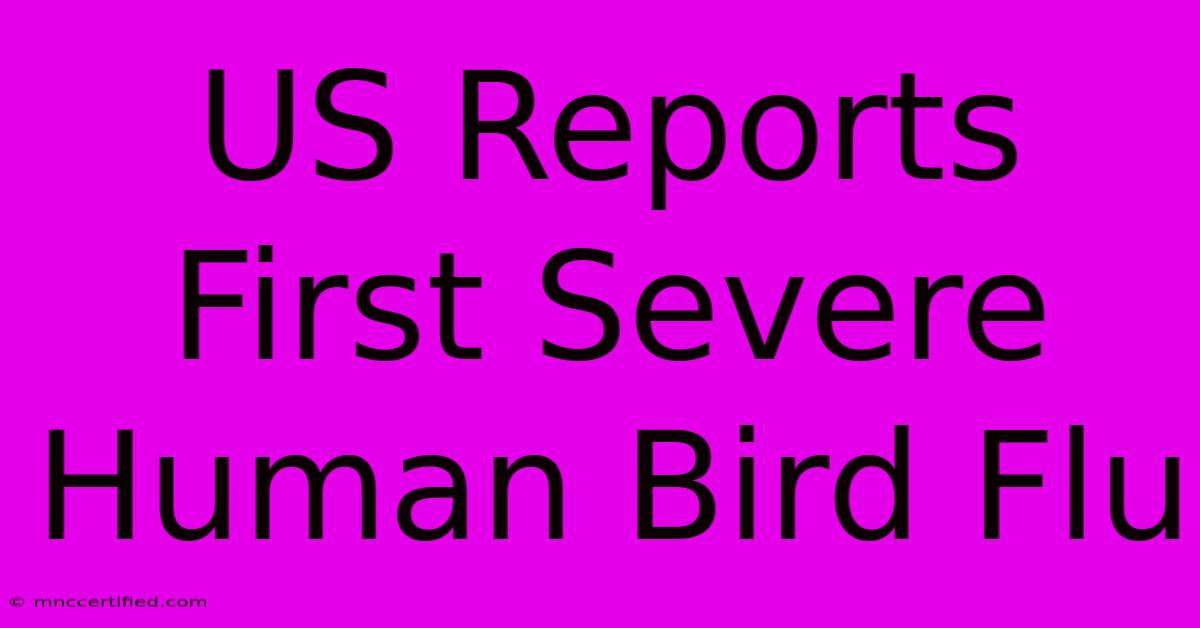US Reports First Severe Human Bird Flu

Table of Contents
US Reports First Severe Human Case of Bird Flu: What You Need to Know
The United States has reported its first severe human case of the H5N1 avian influenza virus, raising concerns about the potential for a wider outbreak. While bird flu infections in humans are relatively rare, this case highlights the importance of understanding the virus, its transmission, and the necessary preventative measures. This article will delve into the details of this significant development and provide crucial information for public health and safety.
Understanding the H5N1 Avian Influenza Virus
H5N1, a highly pathogenic avian influenza virus, primarily affects birds. Human infections are uncommon, usually occurring through close contact with infected poultry or contaminated environments. Symptoms can range from mild respiratory illness to severe pneumonia, potentially leading to death. The severity of this recent case underscores the potential danger posed by this virus.
Key Differences from Previous Cases: Severity and Transmission
While human infections with H5N1 have been documented before, this case stands out due to its severity. Previous cases often presented with milder symptoms. The specifics of transmission in this instance are still under investigation, but it emphasizes the need for ongoing vigilance and robust surveillance. Understanding how this case differed from previous ones is crucial for refining preventative strategies and public health responses.
The Reported Case: Details and Implications
The Centers for Disease Control and Prevention (CDC) and other health authorities are closely monitoring the situation. While the specifics of the patient's condition, location, and potential exposure sources are often withheld to protect patient privacy, the announcement itself has triggered heightened awareness and a renewed focus on biosecurity measures.
Public Health Response and Concerns
The confirmation of a severe human case prompts several key concerns:
- Potential for wider spread: Though human-to-human transmission is currently considered rare, the possibility cannot be entirely dismissed, especially with a more severe strain.
- Strain mutations: The virus could potentially mutate, increasing its transmissibility and severity among humans.
- Strain severity: This case underlines the potentially lethal consequences of H5N1 infection, even in otherwise healthy individuals.
Health officials are working diligently to track potential contacts, implement infection control measures, and educate the public about preventative steps.
Protecting Yourself from Avian Flu
Although the risk of human infection remains relatively low, several precautions can significantly minimize exposure:
- Avoid contact with wild birds: Do not touch or handle sick or dead birds. Report findings to local animal control.
- Practice proper hygiene: Frequent and thorough handwashing is crucial. Use soap and water or an alcohol-based hand sanitizer.
- Cook poultry thoroughly: Ensure that poultry is cooked to an internal temperature of 165°F (74°C) to kill the virus.
- Avoid contact with live poultry markets: Limit exposure to live birds and their droppings.
Staying informed through reputable sources like the CDC and WHO is essential.
The Importance of Ongoing Surveillance and Research
This case underscores the vital need for ongoing surveillance of avian influenza viruses in both birds and humans. Further research is crucial to better understand the virus's evolution, transmission dynamics, and potential for future outbreaks. Early detection and effective response mechanisms are paramount in preventing widespread illness.
Regular updates from health authorities are essential for staying informed about this evolving situation. Consult reliable sources for the latest information and guidance.
Conclusion: Vigilance and Preparedness are Key
The reporting of the first severe human case of H5N1 avian influenza in the US is a significant development, emphasizing the importance of vigilance and preparedness. While the risk to the general public remains low, the potential for severe illness and the possibility of increased transmissibility necessitate a cautious and proactive approach. By following preventative measures and staying informed, we can collectively mitigate the risk and protect public health.

Thank you for visiting our website wich cover about US Reports First Severe Human Bird Flu. We hope the information provided has been useful to you. Feel free to contact us if you have any questions or need further assistance. See you next time and dont miss to bookmark.
Featured Posts
-
Formula 1 Perez Leaves Red Bull
Dec 19, 2024
-
Peter Wright Retires Luke Gets A Mention
Dec 19, 2024
-
House Panel Votes To Release Gaetz Report
Dec 19, 2024
-
Vick To Coach Norfolk State Spartans
Dec 19, 2024
-
Matilda Djerfs Hair Evolution
Dec 19, 2024